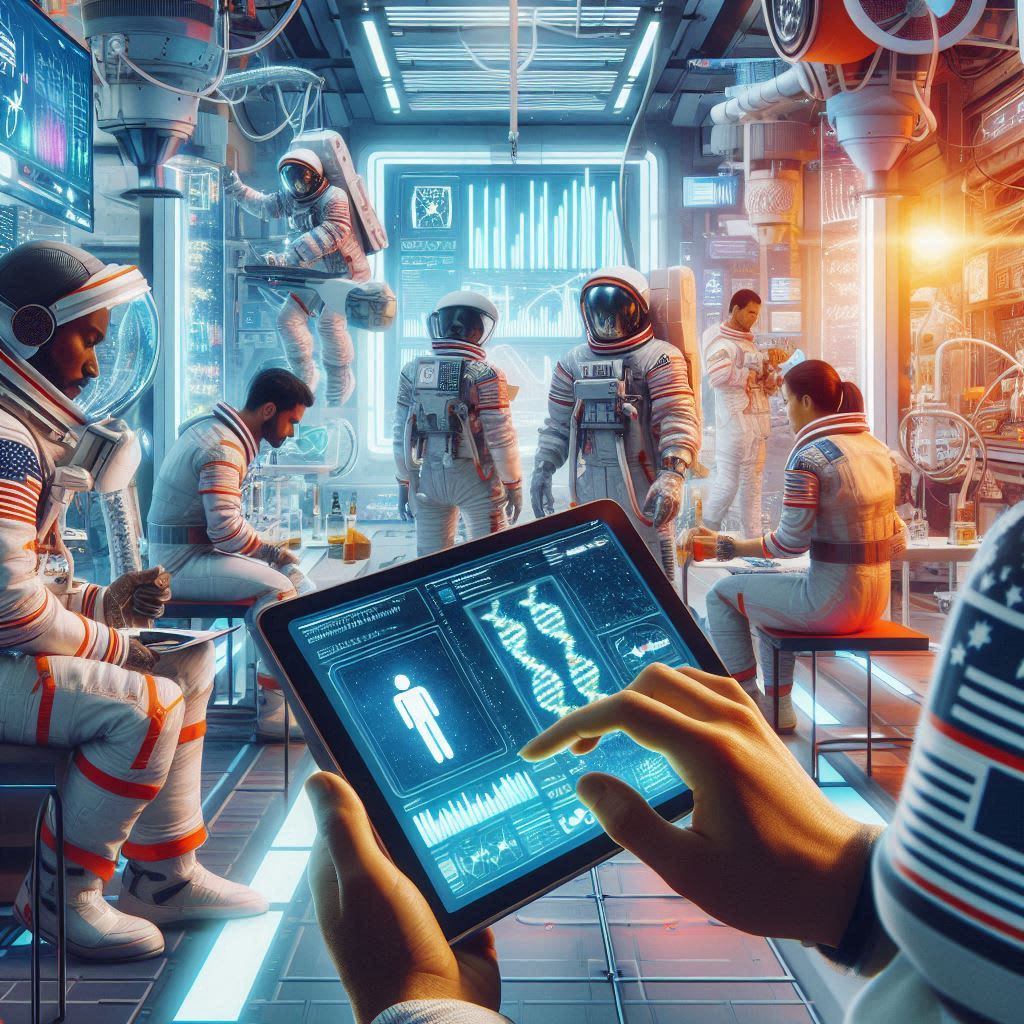Decoding the Astronaut: How Genomics is Revolutionizing Space Travel
DNA Decodes: Revolutionizing Astronaut Safety

Decoding the Astronaut: How Genomics is Revolutionizing Space Travel
Imagine a future where astronauts embark on daring space missions equipped with a personalized "genetic roadmap." This roadmap wouldn't chart the course of their spacecraft, but rather the unique molecular landscape within their own bodies. This isn't science fiction; it's the cutting edge of "Space Age Genomics," a nascent field poised to revolutionize space travel by harnessing the power of genetics to ensure astronaut health and safety.
For decades, space exploration has captivated our imaginations. However, the harsh realities of spaceflight have also become apparent. Astronauts venturing beyond Earth's protective atmosphere face a multitude of challenges, from reduced gravity and radiation exposure to bone loss and muscle atrophy. Traditionally, space agencies have relied on broad preventive measures and rigorous crew selection to mitigate these risks. But what if we could personalize these approaches based on an astronaut's individual genetic makeup?
Unveiling the Astronaut's Genome: The Power of Big Data
The dawn of the "Second Space Age" is marked by a surge in private space ventures alongside established space agencies like NASA and ESA. This era of collaboration has also paved the way for advancements in Space Age Genomics. Here's how this emerging field is transforming space travel:
- Mapping the Astronaut Genome: Advances in DNA sequencing technologies allow scientists to create a detailed genetic profile for each astronaut. This "genetic roadmap" reveals variations in genes associated with response to stress, immune function, bone density, and muscle repair.
- Real-World Example: The Twins Study: NASA's Twins Study, a groundbreaking experiment involving identical twin astronauts Scott and Mark Kelly, shed light on the impact of spaceflight on the human body at a molecular level. Scott spent a year on the International Space Station (ISS) while Mark remained on Earth. Researchers analyzed their genetic profiles before, during, and after the mission. This study identified significant gene expression changes in Scott, particularly those related to DNA repair and the immune system. While the study acknowledges limitations due to the single case design, it provides valuable insights into the potential of Space Age Genomics for monitoring astronaut health during extended space missions.
- Predicting Risks and Tailoring Countermeasures: By analyzing the astronaut's genome, researchers can identify potential vulnerabilities related to spaceflight. For instance, some individuals might have a higher genetic risk for developing bone loss in microgravity. This knowledge allows for personalized countermeasures, such as targeted exercise protocols or specific dietary supplements tailored to their genetic needs.
- Case Study: ESA's Nutrigenomics Project: The European Space Agency (ESA) is pioneering a project in Nutrigenomics, a subfield that explores the interaction of genes and nutrition. Researchers are analyzing astronaut genomes to identify genetic variations influencing dietary needs. This information can be used to develop personalized nutrition plans that optimize nutrient absorption and support astronaut health during space missions.
- Understanding Individual Responses: Space Age Genomics goes beyond a one-size-fits-all approach. By analyzing genetic variations, researchers can gain insights into how individual astronauts might respond to specific challenges of spaceflight. This personalized approach allows for more effective countermeasures and improved mission outcomes.
- Recent Research: Sleep and Circadian Rhythms: Astronauts often experience sleep disruptions due to altered light-dark cycles in space. Recent research suggests that genetic variations might influence individual susceptibility to these disruptions. Understanding these variations allows for the development of personalized sleep protocols and targeted interventions to promote better sleep quality during spaceflight.
Beyond the Horizon: The Evolving Landscape of Space Age Genomics
While the potential of Space Age Genomics is vast, challenges remain. Here's what we need to consider:
- Data Interpretation: Analyzing complex genetic data requires expertise in both genomics and space medicine. Building a strong collaborative network between geneticists, space researchers, and medical professionals is essential for interpreting the data and translating it into actionable insights.
- Ethical Considerations: Access to genetic information raises ethical concerns. Clear guidelines are needed to ensure informed consent, data privacy, and responsible use of genetic data within the context of space exploration.
- The Evolving Frontier: With rapid advancements in space travel technology and the emergence of commercial space ventures, Space Age Genomics needs to be dynamic and adaptable. Ongoing research and development are crucial for keeping pace with this ever-evolving field.
A New Era of Personalized Space Exploration
Space Age Genomics offers a powerful tool for revolutionizing space travel. By harnessing the power of genetics, we can move beyond a one-size-fits-all approach and personalize astronaut health and safety measures. As we venture further into the cosmos, this personalized approach will be key to ensuring the well-being of future space explorers, paving the way for a more sustainable and inclusive future of space exploration.
In Conclusion:
The "Second Space Age" marks a new era of personalized space exploration. Imagine a future where astronauts embark on daring missions equipped with not just their spacesuits and equipment, but also a personalized "genetic roadmap" guiding their healthcare. Astronauts with a higher genetic risk for bone loss in microgravity might receive targeted exercise regimens and specialized bone-strengthening supplements. Those prone to sleep disruptions could utilize personalized light therapy protocols to regulate their circadian rhythms. This level of individualization, enabled by Space Age Genomics, will ensure not just the physical well-being of our space explorers, but also their mental resilience and overall mission success. As we push the boundaries of human exploration, Space Age Genomics promises to be a vital tool in safeguarding the health of astronauts and writing the next chapter in the thrilling story of space travel.
About the Creator
suren arju
Hi there! I'm Suren, your startup guide. Entrepreneur, writer, dreamer - I share insights, tips & stories to fuel your startup journey. Ready to explore, learn & win together? Join me & let's redefine how we launch, learn & leap!
Enjoyed the story? Support the Creator.
Subscribe for free to receive all their stories in your feed. You could also pledge your support or give them a one-off tip, letting them know you appreciate their work.





Comments
There are no comments for this story
Be the first to respond and start the conversation.